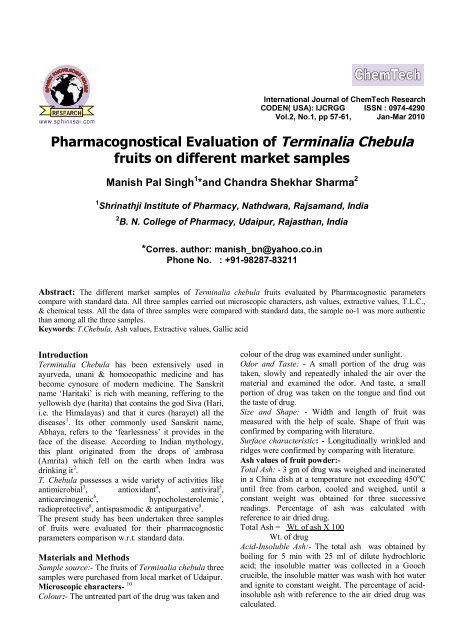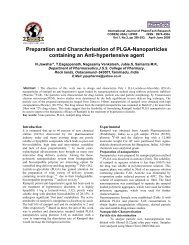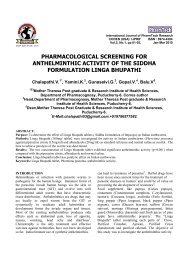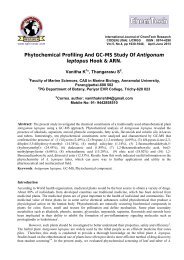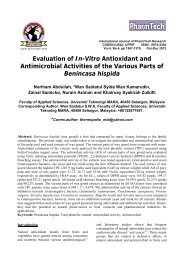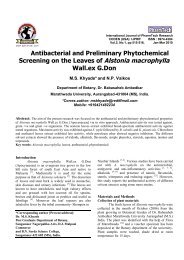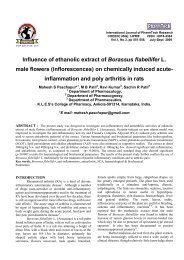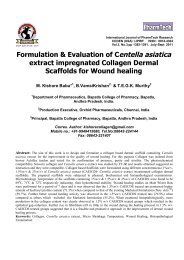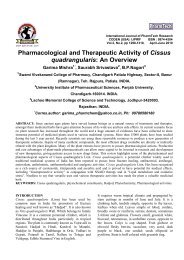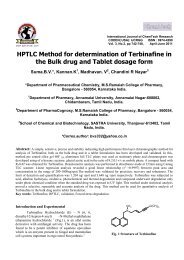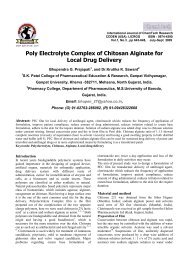Pharmacognostical Evaluation of Terminalia Chebula fruits on ...
Pharmacognostical Evaluation of Terminalia Chebula fruits on ...
Pharmacognostical Evaluation of Terminalia Chebula fruits on ...
You also want an ePaper? Increase the reach of your titles
YUMPU automatically turns print PDFs into web optimized ePapers that Google loves.
Internati<strong>on</strong>al Journal <str<strong>on</strong>g>of</str<strong>on</strong>g> ChemTech Research<br />
CODEN( USA): IJCRGG ISSN : 0974-4290<br />
Vol.2, No.1, pp 57-61, Jan-Mar 2010<br />
<str<strong>on</strong>g>Pharmacognostical</str<strong>on</strong>g> <str<strong>on</strong>g>Evaluati<strong>on</strong></str<strong>on</strong>g> <str<strong>on</strong>g>of</str<strong>on</strong>g> <str<strong>on</strong>g>Terminalia</str<strong>on</strong>g> <str<strong>on</strong>g>Chebula</str<strong>on</strong>g><br />
<str<strong>on</strong>g>fruits</str<strong>on</strong>g> <strong>on</strong> different market samples<br />
Manish Pal Singh 1 *and Chandra Shekhar Sharma 2<br />
1 Shrinathji Institute <str<strong>on</strong>g>of</str<strong>on</strong>g> Pharmacy, Nathdwara, Rajsamand, India<br />
2 B. N. College <str<strong>on</strong>g>of</str<strong>on</strong>g> Pharmacy, Udaipur, Rajasthan, India<br />
*Corres. author: manish_bn@yahoo.co.in<br />
Ph<strong>on</strong>e No. : +91-98287-83211<br />
Abstract: The different market samples <str<strong>on</strong>g>of</str<strong>on</strong>g> <str<strong>on</strong>g>Terminalia</str<strong>on</strong>g> chebula <str<strong>on</strong>g>fruits</str<strong>on</strong>g> evaluated by Pharmacognostic parameters<br />
compare with standard data. All three samples carried out microscopic characters, ash values, extractive values, T.L.C.,<br />
& chemical tests. All the data <str<strong>on</strong>g>of</str<strong>on</strong>g> three samples were compared with standard data, the sample no-1 was more authentic<br />
than am<strong>on</strong>g all the three samples.<br />
Keywords: T.<str<strong>on</strong>g>Chebula</str<strong>on</strong>g>, Ash values, Extractive values, Gallic acid<br />
Introducti<strong>on</strong><br />
<str<strong>on</strong>g>Terminalia</str<strong>on</strong>g> <str<strong>on</strong>g>Chebula</str<strong>on</strong>g> has been extensively used in<br />
ayurveda, unani & homoeopathic medicine and has<br />
become cynosure <str<strong>on</strong>g>of</str<strong>on</strong>g> modern medicine. The Sanskrit<br />
name ‘Haritaki’ is rich with meaning, reffering to the<br />
yellowish dye (harita) that c<strong>on</strong>tains the god Siva (Hari,<br />
i.e. the Himalayas) and that it cures (harayet) all the<br />
diseases 1 . Its other comm<strong>on</strong>ly used Sanskrit name,<br />
Abhaya, refers to the ‘fearlessness’ it provides in the<br />
face <str<strong>on</strong>g>of</str<strong>on</strong>g> the disease. According to Indian mythology,<br />
this plant originated from the drops <str<strong>on</strong>g>of</str<strong>on</strong>g> ambrosa<br />
(Amrita) which fell <strong>on</strong> the earth when Indra was<br />
drinking it 2 .<br />
T. <str<strong>on</strong>g>Chebula</str<strong>on</strong>g> possesses a wide variety <str<strong>on</strong>g>of</str<strong>on</strong>g> activities like<br />
antimicrobial 3 , antioxidant 4 , antiviral 5 ,<br />
anticarcinogenic 6 , hypocholesterolemic 7 ,<br />
radioprotective 8 , antispasmodic & antipurgative 9 .<br />
The present study has been undertaken three samples<br />
<str<strong>on</strong>g>of</str<strong>on</strong>g> <str<strong>on</strong>g>fruits</str<strong>on</strong>g> were evaluated for their pharmacognostic<br />
parameters comparis<strong>on</strong> w.r.t. standard data.<br />
Materials and Methods<br />
Sample source:- The <str<strong>on</strong>g>fruits</str<strong>on</strong>g> <str<strong>on</strong>g>of</str<strong>on</strong>g> <str<strong>on</strong>g>Terminalia</str<strong>on</strong>g> chebula three<br />
samples were purchased from local market <str<strong>on</strong>g>of</str<strong>on</strong>g> Udaipur.<br />
Microscopic characters- 10<br />
Colour:- The untreated part <str<strong>on</strong>g>of</str<strong>on</strong>g> the drug was taken and<br />
colour <str<strong>on</strong>g>of</str<strong>on</strong>g> the drug was examined under sunlight.<br />
Odor and Taste: - A small porti<strong>on</strong> <str<strong>on</strong>g>of</str<strong>on</strong>g> the drug was<br />
taken, slowly and repeatedly inhaled the air over the<br />
material and examined the odor. And taste, a small<br />
porti<strong>on</strong> <str<strong>on</strong>g>of</str<strong>on</strong>g> drug was taken <strong>on</strong> the t<strong>on</strong>gue and find out<br />
the taste <str<strong>on</strong>g>of</str<strong>on</strong>g> drug.<br />
Size and Shape: - Width and length <str<strong>on</strong>g>of</str<strong>on</strong>g> fruit was<br />
measured with the help <str<strong>on</strong>g>of</str<strong>on</strong>g> scale. Shape <str<strong>on</strong>g>of</str<strong>on</strong>g> fruit was<br />
c<strong>on</strong>firmed by comparing with literature.<br />
Surface characteristic: - L<strong>on</strong>gitudinally wrinkled and<br />
ridges were c<strong>on</strong>firmed by comparing with literature.<br />
Ash values <str<strong>on</strong>g>of</str<strong>on</strong>g> fruit powder:-<br />
Total Ash: - 3 gm <str<strong>on</strong>g>of</str<strong>on</strong>g> drug was weighed and incinerated<br />
in a China dish at a temperature not exceeding 450 o C<br />
until free from carb<strong>on</strong>, cooled and weighed, until a<br />
c<strong>on</strong>stant weight was obtained for three successive<br />
readings. Percentage <str<strong>on</strong>g>of</str<strong>on</strong>g> ash was calculated with<br />
reference to air dried drug.<br />
Total Ash = Wt. <str<strong>on</strong>g>of</str<strong>on</strong>g> ash X 100<br />
Wt. <str<strong>on</strong>g>of</str<strong>on</strong>g> drug<br />
Acid-Insoluble Ash:- The total ash was obtained by<br />
boiling for 5 min with 25 ml <str<strong>on</strong>g>of</str<strong>on</strong>g> dilute hydrochloric<br />
acid; the insoluble matter was collected in a Gooch<br />
crucible, the insoluble matter was wash with hot water<br />
and ignite to c<strong>on</strong>stant weight. The percentage <str<strong>on</strong>g>of</str<strong>on</strong>g> acidinsoluble<br />
ash with reference to the air dried drug was<br />
calculated.
Manish Pal Singh et al /Int.J. ChemTech Res.2010,2(1) 58<br />
Extractive values <str<strong>on</strong>g>of</str<strong>on</strong>g> fruit powder:<br />
Alcohol-soluble extractive:- 5 gm <str<strong>on</strong>g>of</str<strong>on</strong>g> accurately<br />
weighed powdered drug was taken in a stoppered<br />
c<strong>on</strong>ical flask and add 100 ml <str<strong>on</strong>g>of</str<strong>on</strong>g> 90% alcohol, and<br />
shake c<strong>on</strong>stantly for 6hr in an electrical shaker and<br />
kept overnight for macerati<strong>on</strong> and then filter carefully<br />
and filter was evaporated to dryness and weight <str<strong>on</strong>g>of</str<strong>on</strong>g><br />
extractive was taken and percentage was calculated<br />
by:-<br />
Alcohol-Soluble<br />
Extractive = Wt. <str<strong>on</strong>g>of</str<strong>on</strong>g> extractive X 100<br />
Wt. <str<strong>on</strong>g>of</str<strong>on</strong>g> drug<br />
Water Soluble extractive: -5 gm <str<strong>on</strong>g>of</str<strong>on</strong>g> accurately weighed<br />
powdered drug was taken in a stoppered c<strong>on</strong>ical flask<br />
and add 100 ml <str<strong>on</strong>g>of</str<strong>on</strong>g> chlor<str<strong>on</strong>g>of</str<strong>on</strong>g>orm water, and shake<br />
c<strong>on</strong>stantly for 6hr in an electrical shaker and kept<br />
overnight for macerati<strong>on</strong> and then filter carefully and<br />
filter was evaporated to dryness and weight <str<strong>on</strong>g>of</str<strong>on</strong>g><br />
extractive was taken and percentage was calculated<br />
by:-<br />
Water-Soluble<br />
Extractive = Wt. <str<strong>on</strong>g>of</str<strong>on</strong>g> extractive X 100<br />
Wt. <str<strong>on</strong>g>of</str<strong>on</strong>g> drug<br />
Chromatographic Studies (T.L.C.): 11<br />
TLC plate dimensi<strong>on</strong>- 7X3 cm<br />
Adsorbent used- Silica gel for TLC<br />
Preparati<strong>on</strong> <str<strong>on</strong>g>of</str<strong>on</strong>g> plates: - Silica gel with a mean pore<br />
width <str<strong>on</strong>g>of</str<strong>on</strong>g> preferably 6 to 10 nm is used as a base<br />
material. As smaller the particles better the separati<strong>on</strong><br />
efficiency. Silica gel plates <str<strong>on</strong>g>of</str<strong>on</strong>g> 0.2 mm thickness were<br />
prepared by spreading method. And final spot taken <strong>on</strong><br />
a precoated silica gel 60 F254 TLC plate (E.Merck) <str<strong>on</strong>g>of</str<strong>on</strong>g><br />
uniform thickness (0.2 mm) and develop it in the<br />
solvent system to a distance <str<strong>on</strong>g>of</str<strong>on</strong>g> 0.8 cm.<br />
Activati<strong>on</strong> plates: - Plates were activated at 105 0 C for<br />
45 min in an electric oven.<br />
Sample Applicati<strong>on</strong>: - 2gm <str<strong>on</strong>g>of</str<strong>on</strong>g> sample powdered drug<br />
was taken in to a c<strong>on</strong>ical flask, add 20 ml 2M<br />
hydrochloric acid and heat <strong>on</strong> a water bath for 30 min<br />
at 100 0 C. Cool and filter. The filtrate was transfer into<br />
a separating funnel and extract with diethyl ether (3x<br />
15 ml). C<strong>on</strong>centrate the combined diethyl ether extract<br />
to 10 ml.<br />
Standard Soluti<strong>on</strong>: - prepare 1mg/ml soluti<strong>on</strong> <str<strong>on</strong>g>of</str<strong>on</strong>g> gallic<br />
acid in water.<br />
Solvent System: - Chlor<str<strong>on</strong>g>of</str<strong>on</strong>g>orm: Ethyl acetate: Formic<br />
acid (2.0: 2.0: 0.8).<br />
Chamber Preparati<strong>on</strong>: - A clean and dry chamber was<br />
taken. The chamber was lined with the filter paper.<br />
The strips <str<strong>on</strong>g>of</str<strong>on</strong>g> filter paper should be cut in such a way<br />
that a window remains allowing observati<strong>on</strong> <str<strong>on</strong>g>of</str<strong>on</strong>g> the<br />
development process. 53 ml <str<strong>on</strong>g>of</str<strong>on</strong>g> the solvent was<br />
introduced to a height <str<strong>on</strong>g>of</str<strong>on</strong>g> 0.5 to 1 cm in the chamber in<br />
order to moisten the filter paper and to equilibrate the<br />
chamber with solvent vapor. The closed chamber was<br />
allowed to saturate with solvent vapor. The TLC was<br />
then introduced in the chamber in such way that the<br />
system just wet the lower edge <str<strong>on</strong>g>of</str<strong>on</strong>g> the plate sorbet. The<br />
solvent system should not wet the part <str<strong>on</strong>g>of</str<strong>on</strong>g> the plate<br />
where the spots were applied, any c<strong>on</strong>tact between the<br />
side <str<strong>on</strong>g>of</str<strong>on</strong>g> the plate and the filter paper should avoid.<br />
Development <str<strong>on</strong>g>of</str<strong>on</strong>g> Chromatogram:-<br />
The solvent migrates up the plate through the sorbet by<br />
capillary acti<strong>on</strong>. The substance was separated as a<br />
result <str<strong>on</strong>g>of</str<strong>on</strong>g> interacti<strong>on</strong> between the samples, mobile and<br />
stati<strong>on</strong>ary phase into individual comp<strong>on</strong>ent. Migrati<strong>on</strong><br />
behavior <str<strong>on</strong>g>of</str<strong>on</strong>g> the separated substance is given in the<br />
form <str<strong>on</strong>g>of</str<strong>on</strong>g> RF value (relative to fr<strong>on</strong>t).<br />
RF = Distance traveled by solute (solute fr<strong>on</strong>t)<br />
Distance traveled by solvent (solvent fr<strong>on</strong>t)<br />
Ascending development <str<strong>on</strong>g>of</str<strong>on</strong>g> chromatogram was d<strong>on</strong>e.<br />
The plate was removed from the chamber, when the<br />
solvent fr<strong>on</strong>t had reached the predetermined height and<br />
the solvent fr<strong>on</strong>t was marked precisely with pencil.<br />
Then the plate was dried and observed under UV light.<br />
Visualizati<strong>on</strong>:-<br />
Scan the plate under UV at 254 nm and 366 nm and<br />
finger print pr<str<strong>on</strong>g>of</str<strong>on</strong>g>ile. Spray the plate with 5% ferric<br />
chloride in methanol. Note the Rf <str<strong>on</strong>g>of</str<strong>on</strong>g> the band<br />
separated.<br />
Phytochemical analysis: 12 Phytochemical screening<br />
procedures carried out were adapted from the previous<br />
work <strong>on</strong> plant analysis. Determinati<strong>on</strong> <str<strong>on</strong>g>of</str<strong>on</strong>g> alkaloids,<br />
0.5g <str<strong>on</strong>g>of</str<strong>on</strong>g> the sample was weighed accurately and<br />
defatted with 5% ethyl ether for15 min. The defatted<br />
sample was extracted for 20 min with 5.0 mL <str<strong>on</strong>g>of</str<strong>on</strong>g><br />
aqueous HCL in a water bath. The resulting mixture<br />
was centrifuged at 3000rpm for 10minto remove<br />
filtrate (supernatant) 1.0 mL <str<strong>on</strong>g>of</str<strong>on</strong>g> the filtrate two<br />
determinati<strong>on</strong>s was treated with a few drops <str<strong>on</strong>g>of</str<strong>on</strong>g><br />
Mayer’s reagent and a sec<strong>on</strong>d 1.0 mL porti<strong>on</strong> was<br />
treated similarly with Dragendorff’ reagent. Turbidity<br />
or precipitati<strong>on</strong>s with either <str<strong>on</strong>g>of</str<strong>on</strong>g> these reagents were<br />
taken as evidence for the presence <str<strong>on</strong>g>of</str<strong>on</strong>g> alkaloids.<br />
Test for Sap<strong>on</strong>in: Ability <str<strong>on</strong>g>of</str<strong>on</strong>g> Sap<strong>on</strong>ins to produce<br />
frothing in aqueous soluti<strong>on</strong> was used as screening test<br />
for the sample 0.5g <str<strong>on</strong>g>of</str<strong>on</strong>g> dried extract was shaken with<br />
water in a test tube, frothing which persist <strong>on</strong> warming<br />
was taken as evidence for the presence <str<strong>on</strong>g>of</str<strong>on</strong>g> Sap<strong>on</strong>ins.<br />
Test for tannins: 5.0g <str<strong>on</strong>g>of</str<strong>on</strong>g> dried extract was stirred<br />
with10.0 mL <str<strong>on</strong>g>of</str<strong>on</strong>g> distilled water. This was filtered and<br />
ferric chloride reagent was added to the filtrate. A<br />
blue, black precipitate was taken as evidence for the<br />
presence <str<strong>on</strong>g>of</str<strong>on</strong>g> tannins.<br />
Test for anthraquin<strong>on</strong>es: 5.0g <str<strong>on</strong>g>of</str<strong>on</strong>g> dried extract was<br />
shaken with 10.0 mL <str<strong>on</strong>g>of</str<strong>on</strong>g> benzene, this was filtered
Manish Pal Singh et al /Int.J. ChemTech Res.2010,2(1) 59<br />
and5.0 mL <str<strong>on</strong>g>of</str<strong>on</strong>g> 10% amm<strong>on</strong>ia soluti<strong>on</strong> was added to the<br />
filtrate. The mixture was shaken and the presence <str<strong>on</strong>g>of</str<strong>on</strong>g><br />
violet colour in the amm<strong>on</strong>ia cal (lower) phase<br />
indicated<br />
the presence <str<strong>on</strong>g>of</str<strong>on</strong>g> free hydroxyanthraquin<strong>on</strong>es.<br />
Test for Cardiac glycosides: 0.5g <str<strong>on</strong>g>of</str<strong>on</strong>g> dried extract was<br />
dissolved in 2.0 mL <str<strong>on</strong>g>of</str<strong>on</strong>g> glacial acetic acid c<strong>on</strong>taining<br />
<strong>on</strong>e drop <str<strong>on</strong>g>of</str<strong>on</strong>g> ferric chloride soluti<strong>on</strong>. This was then<br />
under laid with 1.0 mL <str<strong>on</strong>g>of</str<strong>on</strong>g> c<strong>on</strong>centrated H2SO4. A<br />
brown ring obtained at the interface indicated the<br />
presence <str<strong>on</strong>g>of</str<strong>on</strong>g> cardenolides.<br />
Discussi<strong>on</strong><br />
To ensure reproducible quality <str<strong>on</strong>g>of</str<strong>on</strong>g> herbal products,<br />
proper c<strong>on</strong>trol <str<strong>on</strong>g>of</str<strong>on</strong>g> starting material is utmost essential.<br />
Thus in recent years there has been an emphasis<br />
standardizati<strong>on</strong> <str<strong>on</strong>g>of</str<strong>on</strong>g> medicinal plants <str<strong>on</strong>g>of</str<strong>on</strong>g> therapeutic<br />
potential. Despite the modern techniques,<br />
identificati<strong>on</strong>s evaluati<strong>on</strong> <str<strong>on</strong>g>of</str<strong>on</strong>g> plant drugs by<br />
Pharmacognostic studies is still more reliable, accurate<br />
and in expensive means. According to World Health<br />
Organizati<strong>on</strong> (WHO) the macroscopic and microscopic<br />
descripti<strong>on</strong> <str<strong>on</strong>g>of</str<strong>on</strong>g> a medicinal plant is the first step<br />
towards establishing its<br />
Identity and purity and should be carried out before<br />
any tests are undertaken. Organoleptic evaluati<strong>on</strong> is a<br />
technique <str<strong>on</strong>g>of</str<strong>on</strong>g> qualitative evaluati<strong>on</strong> based <strong>on</strong> the study<br />
<str<strong>on</strong>g>of</str<strong>on</strong>g> morphological and sensory pr<str<strong>on</strong>g>of</str<strong>on</strong>g>iles <str<strong>on</strong>g>of</str<strong>on</strong>g> whole drugs.<br />
The organoleptic or macroscopic studies yielded<br />
important characteristics, such as the fractured surfaces<br />
<str<strong>on</strong>g>of</str<strong>on</strong>g> fresh and dried <str<strong>on</strong>g>fruits</str<strong>on</strong>g>, typical t<strong>on</strong>gue sensitizing<br />
aromatic taste and aromatic and characteristic odour <str<strong>on</strong>g>of</str<strong>on</strong>g><br />
the <str<strong>on</strong>g>fruits</str<strong>on</strong>g> which are useful diagnostic characters.<br />
The residue remaining after incinerati<strong>on</strong> <str<strong>on</strong>g>of</str<strong>on</strong>g> plant<br />
material is the ash c<strong>on</strong>tent or ash value, which simply<br />
represents inorganic salts, naturally occurring in crude<br />
drug or adhering to it or deliberately added to it, as a<br />
form <str<strong>on</strong>g>of</str<strong>on</strong>g> adulterati<strong>on</strong>. The ash value was determined by<br />
three different methods, which measured total ash,<br />
acid-insoluble ash, and water-soluble ash. The total ash<br />
method is employed to measure the total amount <str<strong>on</strong>g>of</str<strong>on</strong>g><br />
material remaining after igniti<strong>on</strong>. This includes both’<br />
Table 1: Details <str<strong>on</strong>g>of</str<strong>on</strong>g> samples <str<strong>on</strong>g>of</str<strong>on</strong>g> <str<strong>on</strong>g>Terminalia</str<strong>on</strong>g> <str<strong>on</strong>g>Chebula</str<strong>on</strong>g> fruit<br />
physiological ash’ which is derived from the plant<br />
tissue itself, and ‘n<strong>on</strong>-physiological ash’, which is the<br />
residue <str<strong>on</strong>g>of</str<strong>on</strong>g> the extraneous matter adhering to the plant<br />
surface. Acid-insoluble ash is a part <str<strong>on</strong>g>of</str<strong>on</strong>g> total as hand<br />
measures the amount <str<strong>on</strong>g>of</str<strong>on</strong>g> silica present, especially ass<br />
and siliceous earth. Water-soluble ash is the water<br />
soluble porti<strong>on</strong> <str<strong>on</strong>g>of</str<strong>on</strong>g> the total ash. These ash values are<br />
important quantitative standards.<br />
The plant material was subjected to preliminary<br />
photochemical screening involving successive solvent<br />
extracti<strong>on</strong> by different solvents in order <str<strong>on</strong>g>of</str<strong>on</strong>g> increasing<br />
polarity to obtain diverse polar and n<strong>on</strong> polar<br />
phytoc<strong>on</strong>stituents possessing different solubility<br />
pattern, followed by various chemical tests for<br />
qualitative detecti<strong>on</strong> <str<strong>on</strong>g>of</str<strong>on</strong>g> various chemical c<strong>on</strong>stituents.<br />
The percent extractives in different solvents indicate<br />
the quantity and nature <str<strong>on</strong>g>of</str<strong>on</strong>g> c<strong>on</strong>stituents in the extract.<br />
The colour <str<strong>on</strong>g>of</str<strong>on</strong>g> the extract sometimes may roughly<br />
indicate the physical and chemical features <str<strong>on</strong>g>of</str<strong>on</strong>g><br />
c<strong>on</strong>stituents present.<br />
Thin layer chromatography (TLC) is particularly<br />
valuable for the preliminary separati<strong>on</strong> and<br />
determinati<strong>on</strong> <str<strong>on</strong>g>of</str<strong>on</strong>g> plant c<strong>on</strong>stituents. As per<br />
photochemical screening the fruit <str<strong>on</strong>g>of</str<strong>on</strong>g> <str<strong>on</strong>g>Terminalia</str<strong>on</strong>g><br />
<str<strong>on</strong>g>Chebula</str<strong>on</strong>g> c<strong>on</strong>tains mainly glycosides. Experimental<br />
c<strong>on</strong>diti<strong>on</strong>s <str<strong>on</strong>g>of</str<strong>on</strong>g> TLC and hence, the obtained Rf value<br />
differed to some extent from that <str<strong>on</strong>g>of</str<strong>on</strong>g> literature. The<br />
chromatographic pr<str<strong>on</strong>g>of</str<strong>on</strong>g>ile may serve as a characteristic<br />
finger print for qualitative <str<strong>on</strong>g>of</str<strong>on</strong>g> <str<strong>on</strong>g>fruits</str<strong>on</strong>g>. After present<br />
investigati<strong>on</strong> it can be c<strong>on</strong>cluded that the<br />
pharmacognostical study <str<strong>on</strong>g>of</str<strong>on</strong>g> fruit <str<strong>on</strong>g>of</str<strong>on</strong>g> <str<strong>on</strong>g>Terminalia</str<strong>on</strong>g><br />
<str<strong>on</strong>g>Chebula</str<strong>on</strong>g> yielded a set <str<strong>on</strong>g>of</str<strong>on</strong>g> qualitative and quantitative<br />
parameters or standards that can serve as an important<br />
source <str<strong>on</strong>g>of</str<strong>on</strong>g> informati<strong>on</strong> to ascertain the identity and to<br />
determine the quality and purity <str<strong>on</strong>g>of</str<strong>on</strong>g> the plant material<br />
in future studies. As previously menti<strong>on</strong>ed, T.<str<strong>on</strong>g>Chebula</str<strong>on</strong>g><br />
being morphologically variable species, these<br />
informati<strong>on</strong> will also be helpful to differentiate<br />
T.<str<strong>on</strong>g>Chebula</str<strong>on</strong>g> from the closely related other species and<br />
varieties <str<strong>on</strong>g>of</str<strong>on</strong>g> <str<strong>on</strong>g>Terminalia</str<strong>on</strong>g> <str<strong>on</strong>g>Chebula</str<strong>on</strong>g> fruit. The all three<br />
samples were compared with standard data the sample<br />
no-1 was more same pharmacognostical parameters.<br />
Sample No. Source Price (Rs /Kg)<br />
Sample-1 S.A. Batliwala(udaipur) 200 /kg<br />
Sample-2 S.S. Batliwala(udaipur) 100/kg<br />
Sample-3 Jawariya Brother’s (udaipur) 100/kg
Manish Pal Singh et al /Int.J. ChemTech Res.2010,2(1) 60<br />
Table- 2: Macroscopic evaluati<strong>on</strong> <str<strong>on</strong>g>of</str<strong>on</strong>g> <str<strong>on</strong>g>Terminalia</str<strong>on</strong>g> <str<strong>on</strong>g>Chebula</str<strong>on</strong>g> fruit<br />
Parameters Standard Value Sample-(1) Sample-(2) Sample-(3)<br />
Odour Odourless Odourless Odourless Odourless<br />
Colour Yellowish brown Yellowish green Yellow Light yellowish<br />
green<br />
Shape Ovoid Ovoid Ovoid Ovoid<br />
Size 3.5 - 4.0 cm length,<br />
1.5 -2.0 cm wide<br />
4.2 cm length, 1.5<br />
cm wide<br />
Taste Astringent Slightly bitter and<br />
sour<br />
Surface L<strong>on</strong>gitudina-lly, L<strong>on</strong>gitudina-lly,<br />
Characteristics Wrinkled, (5-6 Wrinkled (5-<br />
ridges <strong>on</strong> surface) ridges)<br />
4.0 cm<br />
length,<br />
cm wide<br />
2.0<br />
3.3 cm length, 1.9<br />
wide<br />
Bitter Slightly bitter<br />
L<strong>on</strong>gitudinally,<br />
Wrinkled<br />
(6 ridges)<br />
Table- 3: Standardizati<strong>on</strong> <str<strong>on</strong>g>of</str<strong>on</strong>g> <str<strong>on</strong>g>Terminalia</str<strong>on</strong>g> <str<strong>on</strong>g>Chebula</str<strong>on</strong>g> fruit powder<br />
L<strong>on</strong>gitudina-lly,<br />
Wrinkled<br />
(5 ridges)<br />
Parameters Standard<br />
Value<br />
Sample-(1) Sample-(2) Sample-(3)<br />
Total ash #NMT 5 % 2.67% 3.67 % 3.33 %<br />
Acid insoluble ash #NMT 5 % 2.45% 2.85% 2.40%<br />
Alcohol<br />
extractive<br />
soluble ##NLT40% 43.8% 39.0 % 41.6 %<br />
Water soluble extract ##NLT60% 62.8 % 43.8 % 32.8 %<br />
#NMT-Not more than, ##NLT-Not less than<br />
Table- 4: T.L.C. Identificati<strong>on</strong><br />
Sample No. Rf. Values <str<strong>on</strong>g>of</str<strong>on</strong>g> Spot <str<strong>on</strong>g>of</str<strong>on</strong>g><br />
Sample<br />
Sample-1 0.76<br />
Sample-2 0.72<br />
Sample-3 0.70<br />
Gallic acid(standard) 0.82<br />
Table- 5: Results <str<strong>on</strong>g>of</str<strong>on</strong>g> photochemical screenings <str<strong>on</strong>g>of</str<strong>on</strong>g> successive extracts <str<strong>on</strong>g>of</str<strong>on</strong>g> <str<strong>on</strong>g>fruits</str<strong>on</strong>g> <str<strong>on</strong>g>of</str<strong>on</strong>g><br />
<str<strong>on</strong>g>Terminalia</str<strong>on</strong>g> chebula<br />
C<strong>on</strong>stituents Sample-1 Sample-2 Sample-3<br />
Alkaloids -ve - ve - ve<br />
Glycosides + ve + ve + ve<br />
Tannins + ve + ve - ve<br />
Flav<strong>on</strong>oids - ve - ve - ve<br />
+ ve = Present, − ve = Absent
Manish Pal Singh et al /Int.J. ChemTech Res.2010,2(1) 61<br />
Acknowledgement<br />
Authors are thankful to Department <str<strong>on</strong>g>of</str<strong>on</strong>g> Dravyaguna<br />
Vigyana, Nati<strong>on</strong>al Institute <str<strong>on</strong>g>of</str<strong>on</strong>g> Ayurveda, Jaipur,<br />
Rajasthan for the plant authentificati<strong>on</strong>.<br />
References<br />
1. B Das, Materia Medica <str<strong>on</strong>g>of</str<strong>on</strong>g> Ayurveda. (B Jain<br />
Publisher, New Delhi) 1991, 8.<br />
2. Srikanthmurthy K R, Bhavaprakasha <str<strong>on</strong>g>of</str<strong>on</strong>g><br />
Bhavamishr. (Krishnanda Academy,<br />
Varanasi) 2000, 160.<br />
3. Sato Y, Oketani H, Singyouchi K, Ohtsubo T,<br />
Kihara M, Shibata H & Higuti P, Extracti<strong>on</strong><br />
and purificati<strong>on</strong> <str<strong>on</strong>g>of</str<strong>on</strong>g> effective antimicrobial<br />
c<strong>on</strong>stituents <str<strong>on</strong>g>of</str<strong>on</strong>g> <str<strong>on</strong>g>Terminalia</str<strong>on</strong>g> chebula Retz.<br />
Against methicillin- resistant Staphylococcus<br />
aureus, Bull Pharm Bull, 20 (1997) 404.<br />
4. Cheng H Y, Lin T C, Yu K H, Yang C M &<br />
Lin C C, Antioxidant and free radical<br />
scavenging activities <str<strong>on</strong>g>of</str<strong>on</strong>g> <str<strong>on</strong>g>Terminalia</str<strong>on</strong>g> chebula,<br />
Biol Pharm Bull, 26 (2003) 13355.<br />
5. Je<strong>on</strong>g A H N, Kim C Y, Lee J S, Kim T G,<br />
Kim S H, Lee C K, Lee B, Shim C G, Ho<strong>on</strong> H<br />
& Kim J, Inhibitors <str<strong>on</strong>g>of</str<strong>on</strong>g> HIV-1 integrase by<br />
galloyl glucose from <str<strong>on</strong>g>Terminalia</str<strong>on</strong>g> chebula and<br />
flov<strong>on</strong>ol glycoside gallates from Euphorbia<br />
pekinensis, Planta Medica, 68 (2002) 459.<br />
*****<br />
6. Hushum Saleem M, Hark<strong>on</strong>en P & Pihlaja K,<br />
Inhibiti<strong>on</strong> <str<strong>on</strong>g>of</str<strong>on</strong>g> cancer cell growth by crude<br />
extract and phenolics <str<strong>on</strong>g>of</str<strong>on</strong>g> <str<strong>on</strong>g>Terminalia</str<strong>on</strong>g> chebula<br />
fruit, J Ethnopharmacol, 81 (2002) 336.<br />
7. Thakur C P, Thakur B, Singh S & Sinha S K,<br />
The Ayurvedic Medicines Haritaki, Amla and<br />
Bahira reduced cholesterol induced<br />
atherosclerosis in rabbits, Int J Cardiol, 21<br />
(1988) 175.<br />
8. Gandhi N M & Nayar C K K, Radiati<strong>on</strong><br />
protecti<strong>on</strong> by <str<strong>on</strong>g>Terminalia</str<strong>on</strong>g> chebula some<br />
mechanistic aspects, Molecular and Cellular<br />
Biochemistry, 277(2005) 48.<br />
9. Miglani B D, Sen P & Sanyal P K, Purgative<br />
acti<strong>on</strong> <str<strong>on</strong>g>of</str<strong>on</strong>g> an oil obtained from <str<strong>on</strong>g>Terminalia</str<strong>on</strong>g><br />
chebula, Indian J Med Res, 52(1971) 283.<br />
10. “The Ayurvedic Pharmacopoeia <str<strong>on</strong>g>of</str<strong>on</strong>g> India”,<br />
Government <str<strong>on</strong>g>of</str<strong>on</strong>g> India Ministry <str<strong>on</strong>g>of</str<strong>on</strong>g> Health And<br />
Family Welfare Department <str<strong>on</strong>g>of</str<strong>on</strong>g> Indian System<br />
<str<strong>on</strong>g>of</str<strong>on</strong>g> Medicine & Homoeopathy, New Delhi,<br />
(2001), Part-I, Vol-1, pp.-47, 143.<br />
11. “Quality Standards <str<strong>on</strong>g>of</str<strong>on</strong>g> Indian Medicinal<br />
Plants”, Indian Council <str<strong>on</strong>g>of</str<strong>on</strong>g> Medical Research,<br />
New Delhi, (2003), Vol-1, pp.-207-209.<br />
12. Trease, G.E. and W.C. Evans, 1996. Phenols<br />
and phenolic glycosides in Trease and Evans<br />
pharmacognosy and Biliere Tindall L<strong>on</strong>d<strong>on</strong>,<br />
pp: 832.


